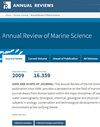变化中的波罗的海:在营养负荷减少和气候变暖之间
IF 18.9
1区 地球科学
Q1 GEOCHEMISTRY & GEOPHYSICS
引用次数: 0
摘要
波罗的海的富营养化在半个多世纪前就被认识到,但它仍然是海洋生态系统的主要威胁。自20世纪80年代以来,波罗的海海洋环境保护委员会(成立于1974年)制定并随后在国家和欧盟法律中实施的要求使磷减少了约50%,氮减少了约30%,但到目前为止,这些措施未能显著改善地表水质量。磷酸盐和耗氧物质长达数十年的积累似乎降低了来自入侵和通过狭窄的波罗的海海峡的主要波罗的海流入的侧向氧气供应的效率。在这些流入期间,深水中磷酸盐循环的动态变化与对河流负荷减少措施的缓慢响应形成鲜明对比。地表水的季节性磷酸盐循环主要来自与大型深水磷酸盐池的交换,基于对其物理驱动因素的更好理解,可以更好地解释这种关键的交换。本文章由计算机程序翻译,如有差异,请以英文原文为准。
The Changing Baltic Sea: Between Nutrient Load Reduction and a Warming Climate
Eutrophication of the Baltic Sea was recognized more than half a century ago, but it remains a major threat to the sea's ecosystem. Requirements developed by the Baltic Marine Environment Protection Commission (formed in 1974) and subsequently implemented in national and European Union law have led to reductions of phosphorus by approximately 50% and nitrogen by approximately 30% since the 1980s, but so far, the measures have failed to significantly improve the surface water quality. A decades-long accumulation of phosphate and oxygen-sapping substances appeared to reduce the efficiency of the lateral supply of oxygen from intrusions and major Baltic inflows via the narrow Baltic Straits. The dynamic change of, in particular, phosphate cycling in deep waters during these inflows contrasts with the sluggish response to river load reduction measures. Seasonal phosphate recycling in surface water results mainly from exchange with the large deep-water phosphate pool, and this key exchange can be better interpreted based on an improved understanding of its physical drivers.
求助全文
通过发布文献求助,成功后即可免费获取论文全文。
去求助
来源期刊

Annual Review of Marine Science
地学-地球化学与地球物理
CiteScore
33.60
自引率
0.60%
发文量
40
期刊介绍:
The Annual Review of Marine Science, published since 2009, offers a comprehensive overview of the field. It covers various disciplines, including coastal and blue water oceanography (biological, chemical, geological, and physical), ecology, conservation, and technological advancements related to the marine environment. The journal's transition from gated to open access through Annual Reviews' Subscribe to Open program ensures that all articles are available under a CC BY license, promoting wider accessibility and dissemination of knowledge.
 求助内容:
求助内容: 应助结果提醒方式:
应助结果提醒方式:


